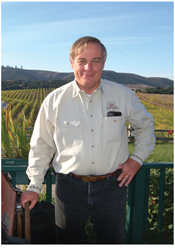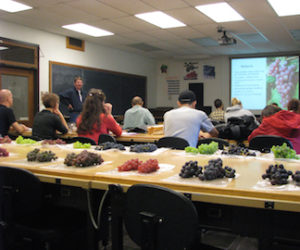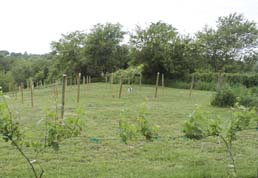
By the second growing season of the Clos Pepe Long Beach vineyard, I observed to Catherine that our vines were quite bountiful, and I announced that I was going to order a 10-gallon barrel, this despite the fact that my harvest of the prior year had only yielded enough grapes for a 3-gallon barrel. Catherine quite astutely pointed out to me that my runaway optimism was affecting my reason. She noted that, given our three different grape varieties that would not all ripen at the same time and the need for extra juice for topping off the barrel and racking, a 5-gallon barrel was the wiser, more appropriate, and less expensive option. And, she further observed that, even if she were wrong, which was a notable rarity, we could still use last year’s three-gallon barrel for any extra topping.
I listened to her “let’s talk reality” contentions, but in this case, my optimism triumphed over logic. “This year’s crop will be the vintage of the century,” I opined with total confidence. And with that, I went out and bought a 10-gallon oak barrel. (Now, what I really wanted was French oak, but the French only export larger barrels to California, i.e., those of 15-, 30- and 60-gallon capacity.)
On August 14th, I picked the 1993 vintage, which due to the cool weather that year, was a late vintage not only in Long Beach but throughout California. The Pinot Noir was 3.3 pH and 23 °Brix, almost perfect. I would have liked the Brix a degree or two higher, but the pH was starting to rise, meaning lower acidity, so I pulled the trigger. Perhaps I should have waited a couple of days for the sugar to rise — ah, the joys of farming! However, the yield was only about 70 pounds or 7 gallons.
Catherine was somewhat miffed that I was using her decorator bathroom scale to weigh the grapes. She ultimately relented, however, concluding that use of a wife’s genteel personal possessions by a part-time farmer husband probably fell under the second modifier in the “for better or worse” covenant to which she had agreed.
Such minor marital accommodations paled compared to the real problem I now confronted. For starters, I was in possession of a 10-gallon barrel, and I had produced only about six gallons of juice. Catherine’s estimation of that year’s yield had been far more accurate than mine, of course, and she lost no time in reminding me of this.
Undaunted, I blithely proceeded to pick the Cabernet Franc, which yielded 31 pounds and the Cabernet Sauvignon, which yielded 25 pounds. But, the Cabernet Franc and Cabernet Sauvignon were not fully ripe, and consequently their pH levels were almost 3 (too acidic) and their Brix (sugar), about 18 degrees (too low). Necessity being the mother of invention, I decided to add the only two bunches of grapes from the two-year-old Nebbiolo vines.
I was about to launch a startling new wine to the world at large, and certainly I would be introducing a blend that oenophiles had never dared contemplate. In fact, it was probably true that no living person had ever so much as tasted an assemblage of Pinot Noir, Cabernet Franc, Cabernet Sauvignon and Nebbiolo. Could there be a reason why? Or was I on the brink of inaugurating an astounding accidental discovery not seen in the wine world since “stuck fermentation” gave birth to White Zinfandel?
My creative blend yielded about nine gallons of juice after pressing. If you do the math, you will realize that this was one gallon short of the capacity of my newly-purchased, against my wife’s wishes, 10-gallon barrel. Now, a married man such as myself will do almost anything to avoid hearing his wife say, “I told you so.” This is especially true when he realizes he must face the fact that she has been totally right all along. I offer this as explanation for the impetuous nature of what I did next. To wit, I added to my 9 gallons of juice five bottles of the then rare and now non-existent 1992 Clos Pepe, from my cellar.
Early in October, I racked this rare blend, but due to evaporation and a leaky American oak barrel (note to self: always buy French), I ended up with eight and four-fifths gallons and a looming 10-gallon barrel yet to fill.
When I tasted the wine and noted it was substantially better than Clos Pepe’s 1992 Long Beach vintage, Catherine commented, “It’s not hard to go up when the boat’s at the bottom of the ocean.
Stephen Pepe is the founder of Clos Pepe Vineyards in Lompoc, California. Wes Hagen, WineMaker’s “Backyard Vines” columnist, is Clos Pepe’s Vineyard Manager and Winemaker. Order Stephen’s book online at http://carnerospress.com.




